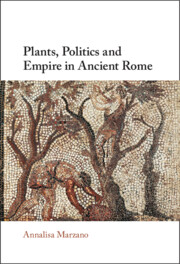Book contents
- Plants, Politics and Empire in Ancient Rome
- Plants, Politics and Empire in Ancient Rome
- Copyright page
- Dedication
- Contents
- Figures
- Tables
- Acknowledgments
- Abbreviations
- Introduction
- Chapter 1 Roman Gardens, Representation, and Politics
- Chapter 2 Arboriculture, ‘Botanical Imperialism’, and Plants on the Move
- Chapter 3 The Augustan ‘Horticultural Revolution’
- Chapter 4 Grafting Glory
- Chapter 5 Of Peaches and Peach Trees
- Chapter 6 Campania and Cisalpine Gaul:
- Chapter 7 Plant Dispersal and Provincial Agriculture
- Chapter 8 Viticulture versus Arboriculture
- Conclusions
- Bibliography
- Index
Chapter 3 - The Augustan ‘Horticultural Revolution’
Published online by Cambridge University Press: 06 October 2022
- Plants, Politics and Empire in Ancient Rome
- Plants, Politics and Empire in Ancient Rome
- Copyright page
- Dedication
- Contents
- Figures
- Tables
- Acknowledgments
- Abbreviations
- Introduction
- Chapter 1 Roman Gardens, Representation, and Politics
- Chapter 2 Arboriculture, ‘Botanical Imperialism’, and Plants on the Move
- Chapter 3 The Augustan ‘Horticultural Revolution’
- Chapter 4 Grafting Glory
- Chapter 5 Of Peaches and Peach Trees
- Chapter 6 Campania and Cisalpine Gaul:
- Chapter 7 Plant Dispersal and Provincial Agriculture
- Chapter 8 Viticulture versus Arboriculture
- Conclusions
- Bibliography
- Index
Summary
Chapter 3 argues that the Augustan era was crucial for the development of commercial arboriculture and horticulture more generally. The interest of Augustan intellectuals in writing works on horticulture, the introduction of new fruits into Italy, the appearance of garden tombs and of specific terms to indicate types of cultivations, the wider application of water-lifting technology to irrigation, all point to a considerable development of horticulture and intensification of cultivations in the late first century BC and the early first century AD.While horticultural exploitation in Rome’s suburbium changed gear during the early principate, the chapter argues that further stimulus to investigate horticultural matters came also from land assignments to veterans in provincial territories and from wealthy landowners who were acquiring an increasing number of properties overseas. Identifying the best varieties to be cultivated commercially in the specific environmental conditions present in the provincial territories must have been of great interest to the farmer-colonists as it was for the Romanized local elites investing in cash crop cultivations.
Keywords
- Type
- Chapter
- Information
- Plants, Politics and Empire in Ancient Rome , pp. 88 - 129Publisher: Cambridge University PressPrint publication year: 2022

